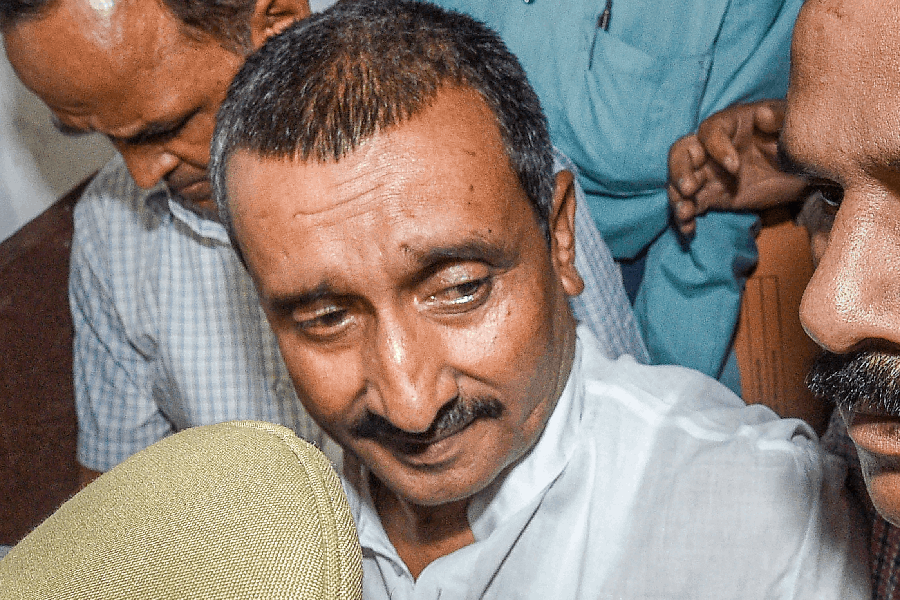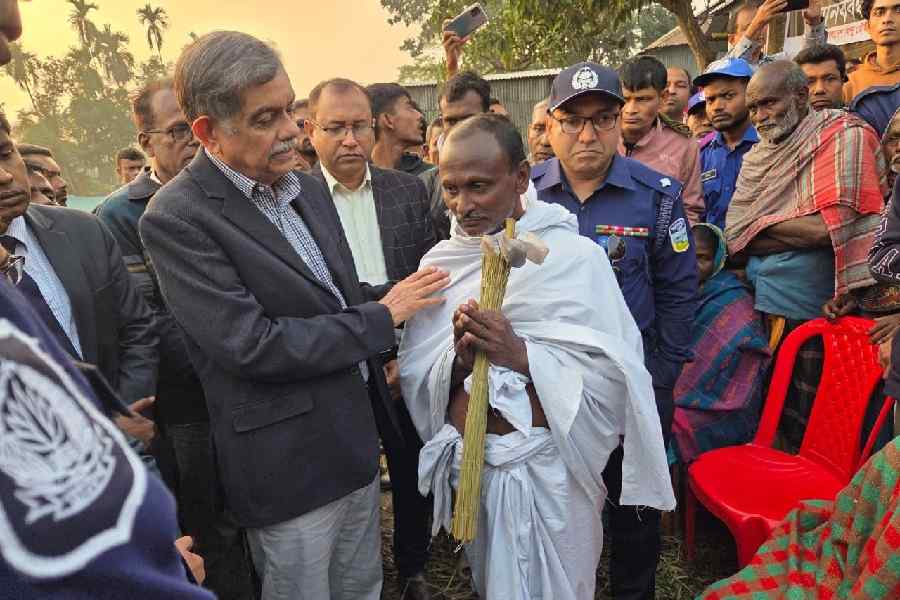 |
The most persistent of evils
Book title: A History of Prejudice: Race, Caste, and Difference in India and the United States
Author: Gyanendra Pandey
Publisher: Cambridge
Pages: 255
Price: Rs 595
Rudrangshu Mukherjee
Prejudice is so embedded in the attitudes of men and women in all societies that it is easy to think of prejudice as a part of the natural order of things. Yet any conception of a better and nobler world has to be free of the idea of prejudice. This, of course, is easier said than done. But one way to approach the problem is to look at the history and the practice of prejudice. Gyanendra Pandey proceeds to do that in this book, which looks at the experience of Dalits in India and of African-Americans.
 |
| Ugly truth |
Prejudice is rooted in difference — differences of colour, race, religion and so on. On the idea of difference is overlaid constructed conceptions of superiority and inferiority, and thus prejudice always articulates itself as a statement of power. The very name, Dalit, conveys a relationship of power since it literally means crushed.
Pandey locates the manifestation of prejudice at two different but intersecting levels and registers. One is what he calls the “vernacular’’ — the visible and often acknowledged and with local variations — caste prejudice, prejudice against blacks, gays, Jews, conquered or immigrant populations, women and so on. These kinds of prejudices, because they are visible and at times explicit, are often condemned. Because of the condemnation, people have become more cautious and reluctant to make public these prejudices. Anti-Semitism is an example of this tendency. This is not to suggest that such prejudices have disappeared. Far from it.
The other level — Pandey calls it “universal’’ — is more difficult to pin down because, in the author’s telling words, it is “everywhere and nowehere’’. It is universal since it “passes for the common sense of modern society, rarely acknowledged as prejudice’’. It is the language of law and the state.
Pandey elaborates this point since it is elusive and often not accepted. The discourse of the enlightened modern emphasizes reason, order, equality, but understates the role of violence in the establishment of capitalism, empire and the nation-state. It avoids its own discomfort with slavery, racism, untouchability, genocide by “declaring them as aberration or exception, the work of deviants or criminals or of people who are simply not modern enough’’. Modernity speaks of freedom, prosperity and peace but for some people the delivery of this promise is always deferred. The non-modern, the backward and the deviant in their various localities become victims of prejudice.
Pandey illustrates the point about the deferral of the promise of modernity with a telling quotation from none other than B.R. Ambedkar. During the Indian Constituent Assembly Debate on the fifth and sixth schedules for “tribal areas’’, he declared, “The Aboriginal Tribes have not as yet developed any political sense to make the best use of their political opportunities and they may easily become mere instruments in the hands either of a majority or a minority and thereby disturb the balance without doing any good to themselves.’’ The “tribes’’ were thus not ready to be full participants in the project of the modern. The modern, Pandey states provocatively, is narrow-minded.
Pandey looks at the experience of two groups which have not easily been appropriated by the narrative of modernity — the African-Americans and the Dalits. In the retrieval and the reconstruction of this experience, the historian faces what appears to be an insurmountable problem. This is the one pertaining to sources and archives, the two principal scaffoldings of the historian’s craft.
 |
Fragrance of pines
Book title: A Family Secret and Other Stories
Author: Bijoya Sawian
Publisher: Zubaan
Pages: 149
Price: Rs 295
Sudipta Bhattacharjee
The modern short story is a fusion of sketch and tale, a distinct and autonomous, though still developing, genre. If Edgar Allan Poe, one of its first exponents, stressed on the “compact, unified effect” of the short story, Bijoya Sawian extends this norm to include a spirited twist at the end, rather like Jeffrey Archer’s compositions.
What makes A Family Secret and Other Stories a charming collection is the all-pervading portrayal of Meghalaya, especially Shillong. The liberal use of Khasi words is an added joy for those familiar with the language, yet not too difficult for other readers to fathom. Khasi customs, traditions and matrilineal traditions comprise the bulwark of the narrative structure.
While most short stories in the 20th century are dominated by a sensitivity to — and experimentation with — form, Sawian has chosen to give primacy to characterisation and plot. The descriptions to flesh out the characters are lively. Take, for instance, “Riiaka, eyes half shut, clutched her sheaf of papers and her handbag tightly and braved the wind with determined steps as her jainsem flapped on her lithe body, like a bird in panic.” It takes very little effort to visualise this, especially one familiar with Shillong in March!
The characterisation is women-oriented: as daughter, mother, sweetheart or sister. Unlike her previous novel, Shadow Men, where the protagonists are male, this volume focuses on relationships viewed through the female prism. Thus we have lovely names likes Saphira, Riiaka, Asorphi, Linsinora and Dalinia, among others, who populate the pages with their grace and beauty, insight and wisdom, recklessness and heartbreak.
The author tries to portray that in spite of being romantic, feminine and sometimes rebellious, the women are very family-oriented.
Sawian’s gentle cadence appears to come from an intrinsic Khasi upbringing, her familiarity with Shillong, Sohra, Delhi and Dehra Dun complimented by a love for Kahlil Gibran and Richard Bach. Hers is a language easy to relate to; fluid and simple, with no unnecessary stylistic embellishments to detract from the linear tale.
Those who know little about Meghalaya get an exposition to the customs and rituals too. “In July, the month of Naitung, people in these eastern hills did not marry mainly because of the inclement weather, just as they avoided April, the month of Iaiong. In April it was the winds…” goes the second story. And in The Girl in a Blue Jainsem: “The Shad Suk Mynsiem, the Dance of Peaceful Hearts, is the only form of community worship among the Khasis, those who are not converted into other faiths and who worship God, U Blei…”
Love, loss and longing are the predominant emotions in these tales. With a touch of Blakesian magic, Sawian’s songs of innocence and experience are lyrical and pantheistic.
The enduring aspect, perhaps, is that the stories, like vintage wine, have a mature blend of wit and irony, sense and sensibility and the ability to stay with the reader long after the covers are closed.
 |
Southern sutra
Book title: Kurundoheir Kabita
Translator: Bijay Sankar Barman
Publisher: Panchajanya
Pages: 120
Price: Rs 110
Bibekananda Choudhury
The poet’s language is not only Tamil; the landscapes, the personae, the appropriate moods, all become a language within a language. Like a native speaker, he makes “infinite use of infinite means”, to say with familiar words what has never been said before; he can say exactly what he wants to, without even being aware of the ground rules of his grammar. If the world is the vocabulary of the poet, the conventions are his syntax
These words of A.K. Ramanujan, the doyen of translation, ushers the reader into this translated compilation.
While many use the word Kurundokai, Prof. Ramanujan adopted the pronunciation Kurundohei, and the translator here has stuck to that while depicting the term in Assamese.
Kurundokai Naanooru means a collection of short poems. They are called Akam poems or poems of love. They belong to what is called Sangam literature in Tamil, that is divided into two parts — Akam and Puram. Puram deals with life in general, while the Akam poems speak exclusively of love. Akam works include Kurundokai, Nattrinai, Eingurunooru and Kalithokai. Kurundokai, being a collection of short poems, contains poems whose lines range between four and eight. These poems were collected by poets of the third Sangam (academy) in the second century. They were written by many poets who lived before the second century.
The Akam poems are expressions of experience. These poems are simple expressions of internal world’s finest experience. The poet creates six-seven characters like that in a drama. One of these is the hero of Kurundokai. He is not from the pages of history – generally the headman of an ethnic group or an administrator. The characters depicting a dramatic moment are the hero, heroine, friend of the heroine, foster mother, concubine and a passerby.
A typical poem starts like this: What she said/ What did her friend say?/ What did he say?/ What did her foster mother say?/ What did the concubine say?/ What did the passerby say?
Here is another: “If one can tell morning/ from noon from listless evening/ the night of sleeping from dawn/ then one’s love/ is a lie”.
It is said that among the total of 401 poems, the heroine is the speaker in 171, the friend of the heroine in 142, the hero in 62, the foster mother in nine, the concubine in six, the passerby in three and the friend of the hero in two, among others.
A research scholar of Folklore Research of Gauhati University and postgraduate of both English and sociology, the author has seven published compilations and several awards in his kitty including the Sahitya Akademy Yuva award in 2013. It is the fruit of a decade’s toil and association with the subject and numerous deliberations with many scholars, including S.A. Vengada Soupraya Nayagar, Prof. M.L. Thangappa, Nirmal Selvamony and B. Ravikumar whose writings about the subject are appended in the collection.
Researchers in Assamese literature may try to find a parallel between Caryapada, the mystic Buddhist poems that has been deduced to have originated in ancient Kamrupa in the seventh century.
 |










